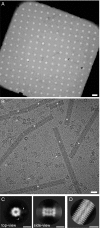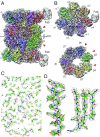Microfluidic protein isolation and sample preparation for high-resolution cryo-EM
- PMID: 31292253
- PMCID: PMC6660723
- DOI: 10.1073/pnas.1907214116
Microfluidic protein isolation and sample preparation for high-resolution cryo-EM
Abstract
High-resolution structural information is essential to understand protein function. Protein-structure determination needs a considerable amount of protein, which can be challenging to produce, often involving harsh and lengthy procedures. In contrast, the several thousand to a few million protein particles required for structure determination by cryogenic electron microscopy (cryo-EM) can be provided by miniaturized systems. Here, we present a microfluidic method for the rapid isolation of a target protein and its direct preparation for cryo-EM. Less than 1 μL of cell lysate is required as starting material to solve the atomic structure of the untagged, endogenous human 20S proteasome. Our work paves the way for high-throughput structure determination of proteins from minimal amounts of cell lysate and opens more opportunities for the isolation of sensitive, endogenous protein complexes.
Keywords: cryo-EM; endogenous; microfluidics; protein purification; sample preparation.
Copyright © 2019 the Author(s). Published by PNAS.
Conflict of interest statement
Conflict of interest statement: H.S. and T.B. declare the following competing financial interest: The cryoWriter concept is part of patent application PCT/EP2015/065398. A former student will found a spin-off for the commercialization of the cryoWriter (March 2019).
Figures



References
-
- Dubochet J., et al. , Cryo-electron microscopy of vitrified specimens. Q. Rev. Biophys. 21, 129–228 (1988). - PubMed
-
- Kühlbrandt W., Biochemistry. The resolution revolution. Science 343, 1443–1444 (2014). - PubMed
-
- Frank J., Averaging of low exposure electron micrographs of non-periodic objects. Ultramicroscopy 1, 159–162 (1975). - PubMed
-
- van Heel M., Frank J., Use of multivariate statistics in analysing the images of biological macromolecules. Ultramicroscopy 6, 187–194 (1981). - PubMed
Publication types
MeSH terms
Substances
LinkOut - more resources
Full Text Sources
Other Literature Sources

